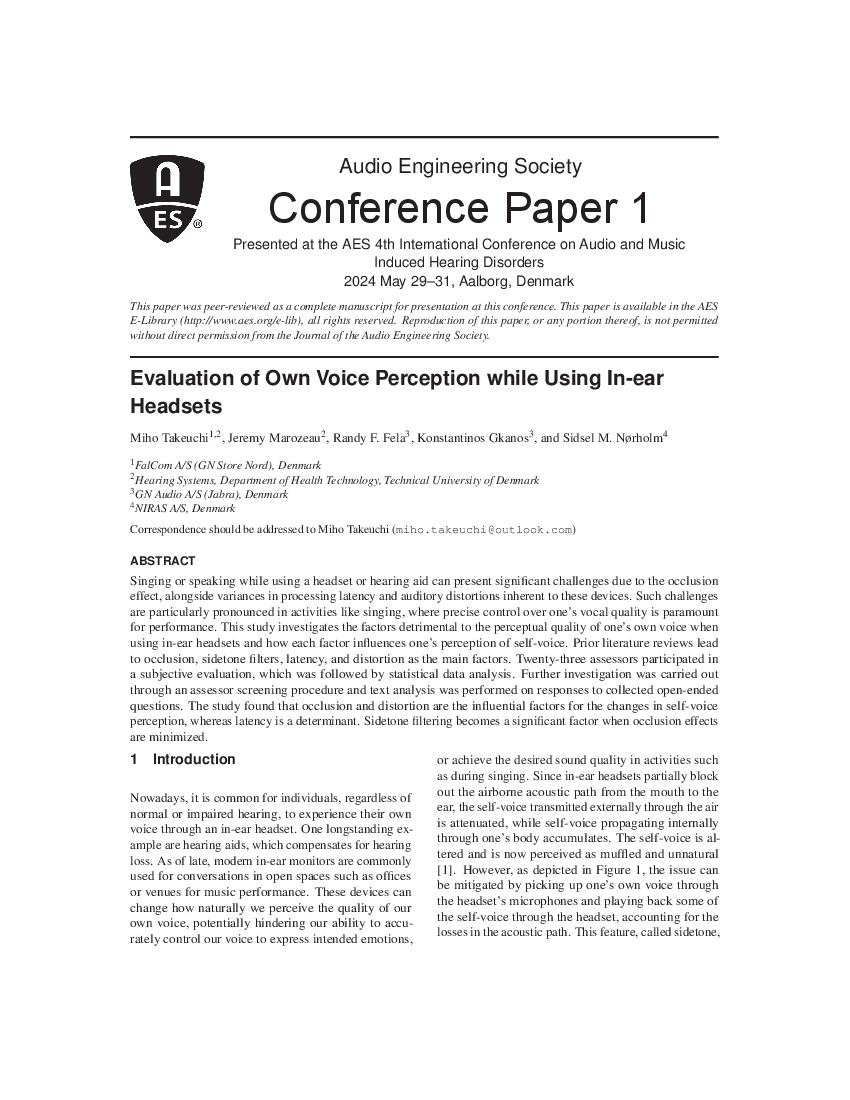Home / Publications / E-library page
You are currently logged in as an
Institutional Subscriber.
If you would like to logout,
please click on the button below.
Home / Publications / E-library page
Only AES members and Institutional Journal Subscribers can download
Singing or speaking while using a headset or hearing aid can present significant challenges due to the occlusion effect, alongside variances in processing latency and auditory distortions inherent to these devices. Such challenges are particularly pronounced in activities like singing, where precise control over one’s vocal quality is paramount for performance. This study investigates the factors detrimental to the perceptual quality of one’s own voice when using in-ear headsets and how each factor influences one’s perception of self-voice. Prior literature reviews lead to occlusion, sidetone filters, latency, and distortion as the main factors. Twenty-three assessors participated in a subjective evaluation, which was followed by statistical data analysis. Further investigation was carried out through an assessor screening procedure and text analysis was performed on responses to collected open-ended questions. The study found that occlusion and distortion are the influential factors for the changes in self-voice perception, whereas latency is a determinant. Sidetone filtering becomes a significant factor when occlusion effects are minimized.
Author (s): Takeuchi, Miho; Marozeau, Jeremy; Fela, Randy F.; Gkanos, Konstantinos; Nørholm, Sidsel M.
Affiliation:
Hearing Systems, Department of Health Technology, Technical University of Denmark; GN Audio A/S (Jabra), Denmark; GN Audio A/S (Jabra), Denmark; NIRAS A/S, Denmark
(See document for exact affiliation information.)
Publication Date:
2024-05-16
Import into BibTeX
Permalink: https://aes2.org/publications/elibrary-page/?id=22419
(815KB)
Click to purchase paper as a non-member or login as an AES member. If your company or school subscribes to the E-Library then switch to the institutional version. If you are not an AES member Join the AES. If you need to check your member status, login to the Member Portal.

Takeuchi, Miho; Marozeau, Jeremy; Fela, Randy F.; Gkanos, Konstantinos; Nørholm, Sidsel M.; 2024; Evaluation of Own Voice Perception while Using In-ear Headsets [PDF]; Hearing Systems, Department of Health Technology, Technical University of Denmark; GN Audio A/S (Jabra), Denmark; GN Audio A/S (Jabra), Denmark; NIRAS A/S, Denmark; Paper 1; Available from: https://aes2.org/publications/elibrary-page/?id=22419
Takeuchi, Miho; Marozeau, Jeremy; Fela, Randy F.; Gkanos, Konstantinos; Nørholm, Sidsel M.; Evaluation of Own Voice Perception while Using In-ear Headsets [PDF]; Hearing Systems, Department of Health Technology, Technical University of Denmark; GN Audio A/S (Jabra), Denmark; GN Audio A/S (Jabra), Denmark; NIRAS A/S, Denmark; Paper 1; 2024 Available: https://aes2.org/publications/elibrary-page/?id=22419
@article{takeuchi2024evaluation,
author={takeuchi miho and marozeau jeremy and fela randy f. and gkanos konstantinos and nørholm sidsel m.},
journal={journal of the audio engineering society},
title={evaluation of own voice perception while using in-ear headsets},
year={2024},
number={1},
month={may},}